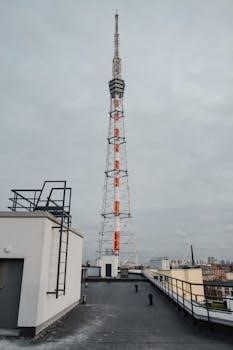
-
By:
- otis
- No comment
practical strategies for technical communication pdf
Technical communication involves conveying complex information clearly and concisely. This skill is vital in various professional fields. Effective strategies are key to successful communication, ensuring messages are understood by the intended audience. Practical approaches are necessary to produce well-structured and accessible technical documents.
The Importance of Technical Communication
In today’s dynamic professional landscape, the significance of technical communication cannot be overstated. It serves as a fundamental pillar for ensuring clarity, precision, and efficiency in the dissemination of specialized information. The ability to articulate technical concepts in a comprehensible manner is not merely an asset; it’s often a necessity for project success, collaboration, and organizational growth. Technical communication bridges the gap between complex processes and diverse audiences, encompassing both experts and non-specialists. It enables the translation of intricate data, procedures, and specifications into clear, actionable insights. This clarity is crucial for avoiding misunderstandings, reducing errors, and streamlining workflows. Furthermore, effective technical communication fosters trust and credibility among stakeholders, clients, and colleagues. It facilitates informed decision-making and drives innovation by ensuring that all parties have access to accurate and well-organized information. The ability to create precise and user-friendly documents, manuals, and instructions is essential for the smooth operation of any technical endeavor. In essence, mastering technical communication is a strategic imperative for any professional aiming to excel in a technically driven world, enhancing both personal and organizational performance.

Core Elements of Technical Communication
Effective technical communication relies on understanding readers, context, and ethical practices. These core elements ensure messages are clear, appropriate, and responsible. Mastering them is crucial for successful technical communication.
Understanding Readers and Contexts
A fundamental aspect of technical communication involves thoroughly understanding your audience. This understanding includes their technical expertise, their needs, and their expectations. It’s crucial to tailor your communication style and content to match the readers’ background. Considering their level of knowledge ensures that the information is presented in an accessible manner. The context in which the communication takes place is equally important. Factors like the purpose of the document, the setting, and the time constraints all influence how information should be conveyed. For instance, a technical manual for experienced engineers will differ greatly from a user guide for general consumers. Recognizing the context enables you to choose the most appropriate language, format, and level of detail. Failing to understand your readers and the contexts might lead to confusion, misinterpretations, and ultimately, ineffective communication. Therefore, thorough audience and context analysis is the cornerstone of any successful technical communication strategy.
Ethical Considerations in Technical Communication
Ethical considerations are paramount in technical communication, emphasizing the importance of honesty, accuracy, and transparency. Technical communicators are responsible for presenting information that is not only clear but also truthful and unbiased. Misleading or falsified data can have serious consequences, ranging from minor inconveniences to significant safety hazards. Therefore, it’s vital to avoid any form of deception, intentional or unintentional. Proper citation of sources is crucial to prevent plagiarism and to acknowledge the contributions of others. Respecting intellectual property rights upholds ethical standards. Furthermore, technical documents should strive to be inclusive and accessible to all users, regardless of their background or abilities. Ethical communication also involves recognizing and addressing potential biases that might affect the presentation of information. By adhering to these principles, technical communicators can build trust and credibility, ensuring that information is used responsibly and effectively. Upholding ethical standards is not only a professional obligation but also a moral imperative.

Practical Strategies for Workplace Communication
Workplace communication requires clear, concise, and effective methods. Practical strategies are essential for crafting impactful messages. Understanding audience and purpose is key to successful workplace interactions, leading to improved productivity and collaboration.
Writing Effective Letters, Memos, and Emails
Crafting effective letters, memos, and emails is crucial in technical communication. These documents often serve as primary forms of professional interaction, thus demanding clarity and precision. When writing letters, it’s important to maintain a formal tone while ensuring all relevant information is clearly stated. Memos, typically for internal communication, should be concise and to the point, focusing on specific objectives or updates. Emails, the most frequent form of workplace communication, must be carefully composed with a clear subject line, a concise message, and a professional closing. Effective email writing means considering the recipient’s time and using proper grammar and punctuation. Remember to use a professional tone in all types of written communication, including using appropriate formatting. When producing these documents, consider your readers and their needs. Each type serves a different purpose and it is important to use proper style and formatting for each one. The use of clear language can greatly improve the impact of your written messages. These practical strategies will result in documents that are effective and easy to understand.
Crafting Technical Descriptions and Specifications
Technical descriptions and specifications are vital for conveying details about products, processes, or systems. These documents must be precise, unambiguous, and comprehensive, catering to the needs of various audiences including engineers, clients, and regulatory bodies. When creating technical descriptions, it is essential to use clear, objective language avoiding jargon where possible. Start by identifying the purpose and scope of your description, then proceed with a logical structure that covers all key elements. In specifications, focus on quantifiable parameters and measurable attributes. Include all pertinent details, such as dimensions, performance metrics, and material requirements. Utilizing visual aids like diagrams, charts, and tables can greatly enhance understanding and reduce the possibility of misinterpretations. Technical writers should make use of a structured approach, carefully planning the document to ensure it is organized and easy to navigate. Thoroughness and accuracy in these documents are critical because they serve as a basis for design, manufacturing, and evaluation. Precision here can reduce errors and inefficiencies in the future.
Creating Clear Instructions and Documentation
Creating clear instructions and documentation is essential for user understanding and proper implementation of a product or process. The primary goal is to guide users through tasks efficiently and accurately. Start by identifying the target audience and their level of expertise. Write using straightforward language, avoiding technical jargon, and defining any necessary terms. Use a logical and sequential approach, breaking down complex tasks into simpler steps. Number or use bullet points to make the instructions easy to follow. Visual aids such as diagrams, screenshots, and videos can enhance clarity and comprehension, and these should be included where appropriate. Consistency is critical, maintain a uniform style throughout the document. Always test the instructions with representative users to identify any areas of confusion or ambiguity and revise accordingly. Documentation should include troubleshooting tips and error messages. It must be easily searchable and well organized, making it simple to locate specific information. Regular updates are essential to reflect changes in the product or process, ensuring continued accuracy and usefulness.

Advanced Strategies and Techniques
Advanced strategies enhance technical communication by focusing on collaboration and research integration. Technology use is key for efficiency. These techniques enable complex projects and improve document quality and impact, crucial in professional environments.
Collaborative Writing and Teamwork
Collaborative writing is a cornerstone of modern technical communication, requiring teams to work cohesively towards a unified document. It involves sharing responsibilities, utilizing individual strengths, and managing different writing styles to create a cohesive final product. Effective teamwork requires clear communication, defined roles, and adherence to agreed-upon timelines. Tools like shared document platforms, version control, and regular team meetings are crucial for facilitating smooth collaboration. Furthermore, constructive feedback and revision processes are vital for improving document quality and ensuring consistency. Teams must also navigate potential conflicts and differing opinions to maintain progress and meet deadlines. In the realm of technical communication, effective collaborative writing transcends individual limitations, leveraging collective expertise to produce high-quality documents. Integrating diverse skill sets leads to richer, more comprehensive content. Ultimately, success depends on open communication, mutual respect, and a shared commitment to excellence in technical writing.
Integrating Research into Technical Documents
Integrating research into technical documents is essential for credibility and accuracy. This process involves gathering relevant information from reliable sources and synthesizing it effectively into the document. It requires careful planning to determine the scope and type of research needed, whether it’s quantitative or qualitative data. Proper citation and referencing are crucial for avoiding plagiarism and acknowledging the work of others. Furthermore, research findings should be presented in a clear and concise manner, aligning with the document’s purpose and audience. Data visualization through graphs and charts enhances understanding of complex research results. The process also includes critically evaluating sources to ensure their validity and relevance. Effective integration transforms raw data into meaningful insights that support the document’s arguments and recommendations. It requires a methodical approach to ensure research is both thorough and clearly communicated, enhancing the document’s overall integrity and persuasive power.
Utilizing Technology in Technical Communication
Technology plays a pivotal role in modern technical communication, offering numerous tools and platforms to enhance efficiency and reach. Software for document creation, such as word processors and desktop publishing applications, is fundamental for producing professional-looking documents. Content management systems (CMS) facilitate collaborative writing and document version control, ensuring consistency and accuracy. Furthermore, online platforms for sharing and disseminating information, like websites and knowledge bases, have expanded the accessibility of technical documentation. Multimedia tools for creating videos, animations, and interactive simulations enhance user engagement and comprehension. Authoring tools and single-source publishing methods allow for content reuse across different formats, saving time and resources. AI-powered tools for grammar and style checking improve writing quality and consistency. Effective use of technology streamlines workflows, reduces costs, and enables technical communicators to create more impactful and accessible content. These tools have become integral to modern technical communication practices.

Evolving Trends in Technical Communication
Technical communication is rapidly changing with new technologies and methods. Generative AI impacts writing, while job search strategies require adaptability. Professionals must enhance skills and address emerging demands for clear communication. Evolving trends shape how we approach technical writing.
Generative AI and its Impact on Technical Writing
Generative AI tools are reshaping technical writing, offering new possibilities and challenges. These tools can assist in drafting content, providing quick solutions for creating technical documents. However, the impact of AI goes beyond mere assistance. AI algorithms can analyze vast datasets to identify patterns and trends in technical communication, allowing writers to create more effective content. This technology can also be used to personalize communication, adjusting tone and style to different audiences.
The use of generative AI introduces considerations regarding ethics and accuracy. Ensuring the integrity of the information generated by AI requires careful monitoring. Technical writers must critically review AI-generated text for errors and biases. The human element remains crucial in ensuring clarity and precision. While AI can enhance productivity, it cannot replace the expertise and judgment of human writers. Therefore, technical communicators must adapt their skills to effectively integrate AI into their workflows and maintain high standards.
Job Search and Career Strategies in Technical Communication
A career in technical communication demands a strategic approach to job searching and professional development. Effective job applications require showcasing not only writing skills but also a strong understanding of technical concepts. Preparing compelling resumes and portfolios that highlight experience with various technical documents is essential; Networking within the technical communication community can open doors to new opportunities. Utilizing online platforms and professional organizations can help connect with potential employers.
Developing expertise in specific areas, such as information design or user experience, can make candidates more competitive. Continuous learning is crucial, as the field of technical communication evolves with technological advancements. Adapting to new tools and methodologies, including generative AI, is necessary for career growth. Technical communicators must also focus on honing soft skills, such as collaboration and communication, to excel in their roles. Proactive career management and a commitment to continuous improvement are key for long-term success.